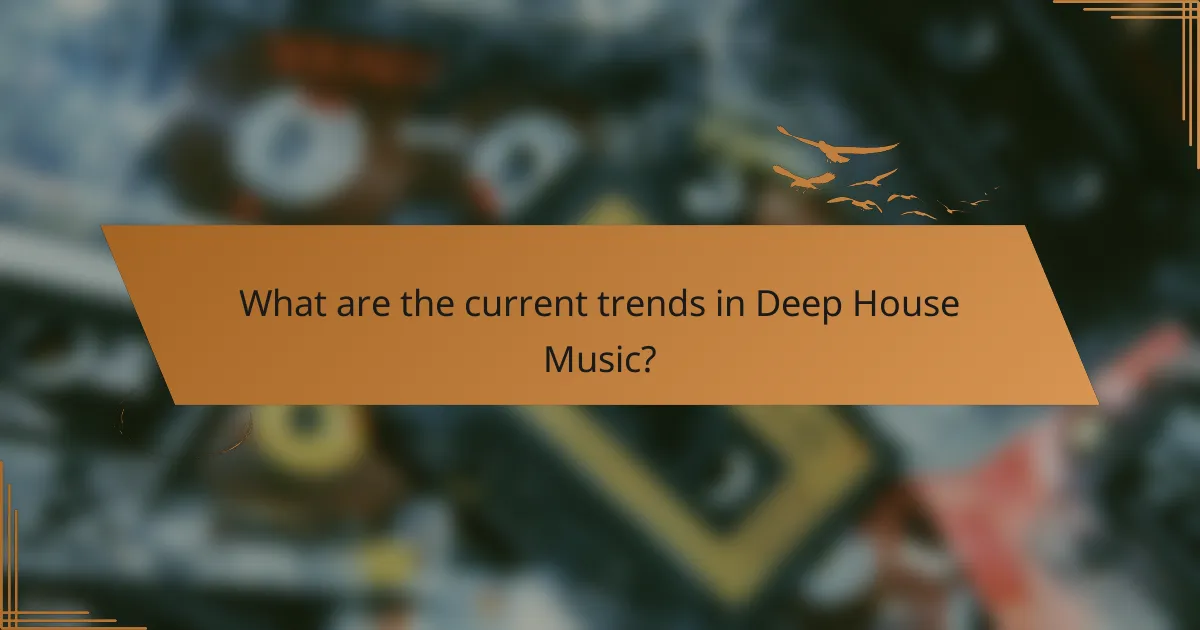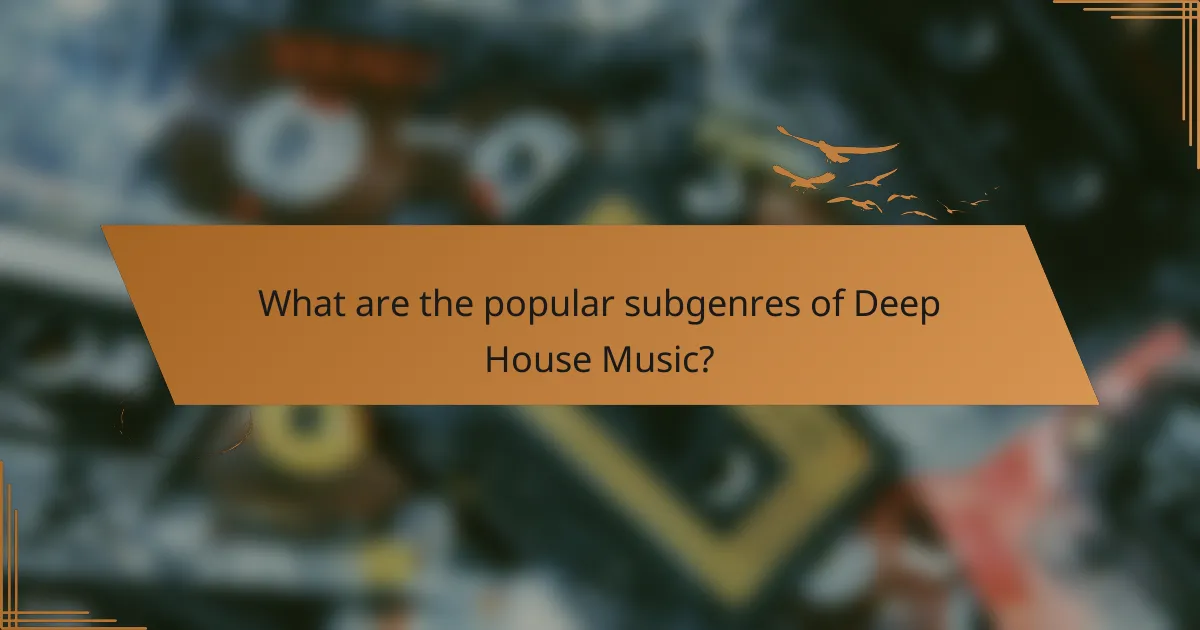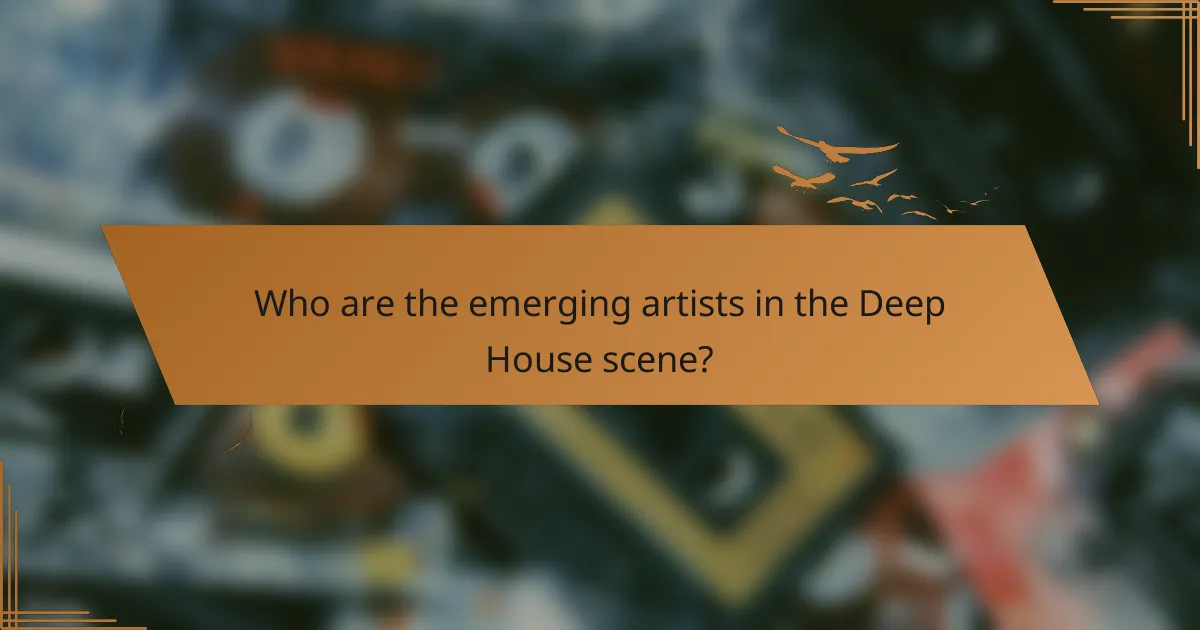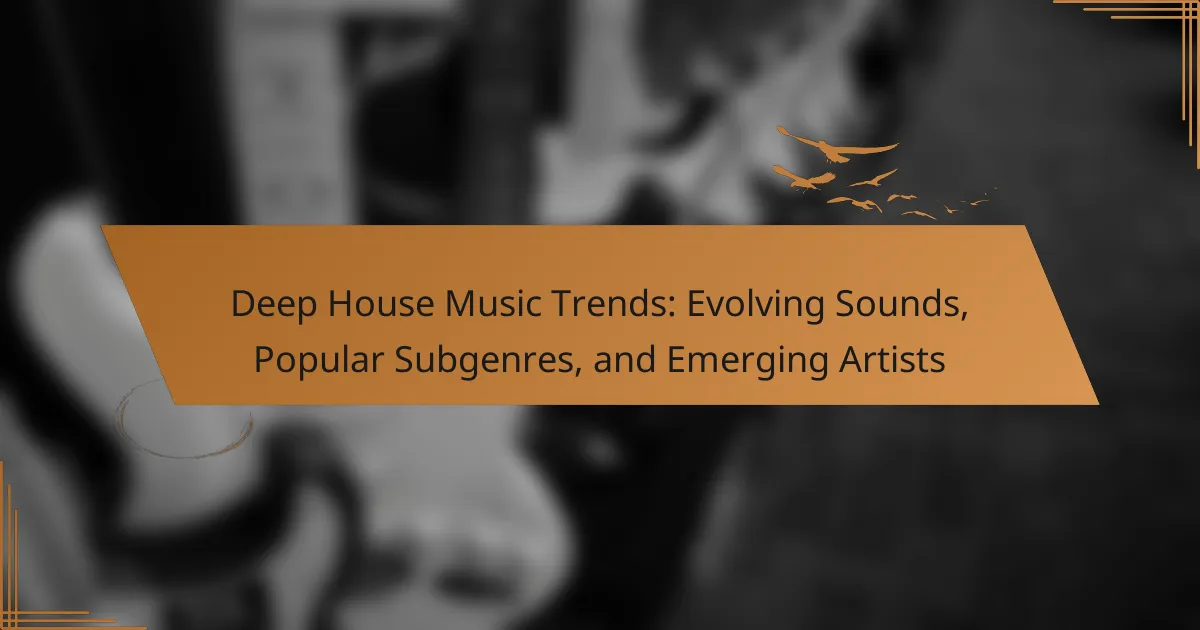Deep house music is currently experiencing significant trends characterized by a fusion of genres, increased use of live instrumentation, and an emphasis on melodic elements. Notable subgenres such as soulful house, tech house, and atmospheric deep house illustrate the diversity within this genre, each appealing to different audiences through unique characteristics. Emerging artists like Ben Böhmer, Nora En Pure, Yotto, and Lane 8 are making impactful contributions, showcasing innovative sounds and gaining popularity at major festivals. The evolution of deep house music reflects a growing emotional depth in tracks, resonating with listeners and enhancing its presence in mainstream events.

What are the current trends in Deep House Music?
Current trends in Deep House Music include a fusion of genres, increased use of live instrumentation, and a focus on melodic elements. Artists are blending deep house with elements of techno, jazz, and even indie music. This genre is also seeing a rise in the popularity of vocal collaborations. Emerging artists are experimenting with unique soundscapes and incorporating organic sounds. The use of technology in production is evolving, with more producers utilizing software to create intricate layers. Additionally, deep house is gaining traction in festivals and mainstream events. The emotional depth of tracks is becoming a significant trend, resonating with listeners on a personal level.
How has Deep House Music evolved over the years?
Deep House Music has evolved significantly since its inception in the 1980s. Initially, it blended elements of jazz, soul, and funk, creating a smooth and melodic sound. The genre gained popularity in Chicago, with artists like Frankie Knuckles and Larry Heard paving the way. In the 1990s, Deep House diversified, incorporating more electronic elements and varying tempos.
The rise of digital production tools in the 2000s allowed for greater experimentation. This led to the emergence of subgenres like microhouse and soulful house. In the 2010s, Deep House experienced a resurgence in mainstream popularity, influenced by artists like Disclosure and Duke Dumont.
Today, Deep House continues to evolve, with influences from genres like techno and ambient music. The genre is characterized by its rich, atmospheric soundscapes and intricate rhythms. Festivals and online platforms have further facilitated its global reach, introducing new artists and sounds to diverse audiences.
What key influences have shaped the sound of Deep House?
Deep House music has been shaped by several key influences. The Chicago house scene of the 1980s laid the foundation for its sound. Artists like Frankie Knuckles and Larry Heard infused soulful elements into house music. Detroit techno also contributed, emphasizing rhythmic complexity and electronic instrumentation. Jazz and funk influences added melodic depth and groove. The use of samples from disco and soul tracks is prevalent in Deep House. Vocal elements often feature emotional and introspective lyrics. The genre’s development was also influenced by the rise of digital production tools in the 1990s. These tools allowed for greater experimentation and accessibility for new artists.
How do technological advancements impact Deep House production?
Technological advancements significantly enhance Deep House production. They provide access to sophisticated software and hardware tools. Digital Audio Workstations (DAWs) allow for intricate sound manipulation. Synthesizers and samplers create unique soundscapes. MIDI technology facilitates precise control over musical elements. Online collaboration tools enable artists to work together remotely. Streaming platforms broaden the audience reach for new releases. These advancements ultimately lead to innovative sounds and production techniques in Deep House music.
What are the defining characteristics of Deep House Music?
Deep House Music is characterized by its smooth, soulful sound and deep basslines. It typically features slower tempos, ranging from 120 to 125 BPM. The genre often incorporates elements of jazz, funk, and soul music. Vocals in deep house tend to be soft and melodic, enhancing its emotional depth. The use of atmospheric pads and lush synths creates a rich soundscape. Additionally, deep house often employs complex chord progressions. This genre emphasizes groove and rhythm, encouraging a relaxed dance experience. Its origins trace back to the 1980s Chicago house scene, influenced by artists like Larry Heard.
What instruments and sounds are commonly used in Deep House?
Deep House commonly utilizes synthesizers, drum machines, and basslines. Synthesizers create lush chords and melodic elements. Drum machines provide the characteristic four-on-the-floor beat. Basslines are often deep and groovy, adding rhythm and texture. Additionally, vocal samples are frequently used to enhance the atmosphere. Pads and atmospheric sounds contribute to the genre’s smooth, immersive quality. Percussion instruments add complexity and depth to the overall sound. These elements combine to create the signature Deep House vibe.
How does the tempo and rhythm distinguish Deep House from other genres?
Deep House is distinguished by its unique tempo and rhythm. Typically, Deep House tracks have a tempo ranging from 120 to 125 BPM. This tempo creates a laid-back yet danceable feel. The rhythm often incorporates complex, syncopated beats. These rhythms are more intricate compared to genres like Techno or House. Deep House also frequently features smooth, flowing basslines. This contrasts with the more aggressive beats found in genres like Dubstep. The combination of these elements creates a distinct atmosphere in Deep House music.

What are the popular subgenres of Deep House Music?
The popular subgenres of Deep House Music include soulful house, tech house, and atmospheric deep house. Soulful house emphasizes rich vocals and jazzy elements. Tech house combines techno beats with house rhythms. Atmospheric deep house features ambient sounds and melodic elements. These subgenres reflect the diversity within deep house music. Each has its unique characteristics that appeal to different audiences. The growth of these subgenres showcases the evolution of deep house over time.
How do subgenres like Soulful House and Tech House differ from traditional Deep House?
Soulful House and Tech House differ from traditional Deep House primarily in their musical elements and emotional expression. Soulful House emphasizes rich melodies, vocal performances, and a warm, uplifting vibe. It often incorporates elements of gospel and R&B, creating a more emotional and soulful listening experience. In contrast, Tech House focuses on a minimalistic approach, featuring repetitive beats, synthesized sounds, and a driving bassline. This subgenre leans towards a more rhythmic and energetic feel, suitable for dance floors. Traditional Deep House combines elements of both but is generally characterized by its smooth, jazzy undertones and deep basslines. The distinctions highlight how Soulful House prioritizes emotional connection, while Tech House emphasizes rhythm and energy.
What are the key features of Soulful House music?
Soulful House music is characterized by its rich vocal elements and deep, emotive melodies. It often incorporates gospel, jazz, and funk influences. The genre typically features smooth, soulful vocals layered over lush instrumentals. Rhythmic grooves are essential, creating a danceable yet emotional experience. The use of live instruments, like piano and horns, is common, enhancing its organic feel. Additionally, Soulful House often includes uplifting themes and positive messages in its lyrics. This genre emerged in the 1990s, gaining popularity in clubs and festivals worldwide. Its unique blend of styles distinguishes it from other house music subgenres.
How does Tech House incorporate elements of Deep House?
Tech House incorporates elements of Deep House through its use of melodic basslines and atmospheric synths. Both genres share a focus on groove and rhythm. Tech House often features the soulful vocal samples typical of Deep House. The tempo of Tech House aligns closely with the slower beats found in Deep House tracks. Additionally, both genres emphasize deep, resonant bass that creates an immersive listening experience. The blending of these elements results in a hybrid sound that appeals to fans of both styles. This integration has been evident in tracks by artists like Green Velvet and Claude VonStroke, who often fuse these genres in their productions.
What role do regional styles play in Deep House subgenres?
Regional styles significantly influence Deep House subgenres by introducing unique cultural elements. Each region contributes distinct rhythms, instrumentation, and vocal styles. For example, Chicago’s Deep House often features soulful vocals and jazz influences. Conversely, European subgenres may incorporate more minimalistic beats and electronic elements. These regional characteristics create diverse sounds within the broader Deep House genre. This variation enriches the overall music landscape, appealing to different audiences worldwide. The interplay of regional styles fosters innovation and keeps the genre evolving.
How do European and American Deep House styles compare?
European and American Deep House styles differ primarily in their sound aesthetics and cultural influences. European Deep House often incorporates elements of techno and minimalism. It features smoother, more melodic lines with a focus on atmospheric soundscapes. This style emphasizes intricate production techniques and often includes jazz or soul influences.
In contrast, American Deep House tends to have a more soulful and vocal-driven approach. It frequently incorporates elements of funk and R&B. The rhythm is often more prominent, creating a danceable groove.
The differences can be traced back to their origins. European Deep House emerged in the late 1980s from the Chicago House scene but evolved with a distinct emphasis on melody and mood. American Deep House, while rooted in the same Chicago House, maintained a strong connection to its soulful and vocal traditions.
Overall, while both styles share a common heritage, their unique characteristics reflect their cultural contexts and musical influences.
What unique attributes do Asian Deep House artists bring to the genre?
Asian Deep House artists bring diverse cultural influences and unique soundscapes to the genre. Their music often incorporates traditional instruments and melodies, creating a fusion of modern and ethnic sounds. This blend adds richness and depth to the overall listening experience. Additionally, Asian artists frequently explore themes of [censured] and nature in their lyrics and compositions. This thematic focus can resonate with listeners on a personal level. Collaborations with local musicians enhance the authenticity of their tracks. The distinct rhythmic patterns and vocal styles often reflect regional musical traditions. This results in a refreshing take on the Deep House genre. Overall, Asian Deep House artists contribute a unique cultural perspective that broadens the genre’s appeal.

Who are the emerging artists in the Deep House scene?
Emerging artists in the Deep House scene include artists like Ben Böhmer, who gained recognition for his melodic approach. Another notable name is Nora En Pure, known for her unique blend of deep house and melodic elements. Additionally, artists like Yotto and Lane 8 are also making waves with their innovative sounds. These artists have been featured in major festivals and have significant followings on streaming platforms. Their contributions reflect the evolving nature of deep house music, incorporating various influences and styles.
What characteristics define successful emerging Deep House artists?
Successful emerging Deep House artists often possess a unique sound that blends various musical influences. This sound typically includes elements from genres like jazz, soul, and funk. Additionally, they demonstrate strong production skills, allowing them to create polished tracks that resonate with listeners. Networking and collaboration within the music community are also crucial, as these connections can lead to more exposure and opportunities.
Moreover, successful artists engage with their audience through social media and live performances. They often showcase a distinct visual identity that complements their music. Staying updated with current trends while maintaining authenticity is essential for longevity in the industry. Furthermore, they frequently release new music to keep their audience engaged and interested.
How do these artists utilize social media to gain recognition?
Artists in deep house music utilize social media to gain recognition by sharing their music, engaging with fans, and collaborating with other artists. They post tracks, remixes, and live sets on platforms like SoundCloud, Instagram, and YouTube. This exposure helps them reach wider audiences. Engaging content, such as behind-the-scenes footage and personal stories, fosters a connection with listeners. Collaborations often result in cross-promotion, expanding their reach. Additionally, artists participate in challenges and trends on platforms like TikTok to increase visibility. Social media analytics show that consistent posting can significantly boost follower counts and engagement rates.
What are some notable collaborations that have elevated new artists in Deep House?
Notable collaborations that have elevated new artists in Deep House include those between established and emerging talents. For example, the collaboration between Duke Dumont and Jax Jones on “I Got U” introduced new sounds and showcased rising artist Jax Jones. Another significant partnership was between Disclosure and Sam Smith on “Latch,” which propelled Smith into the mainstream. The collaboration between CamelPhat and Elderbrook on “Cola” also gained widespread acclaim and recognition for Elderbrook. These partnerships often result in chart-topping hits and increased visibility for new artists in the genre.
Which platforms are best for discovering new Deep House talent?
SoundCloud, Bandcamp, and Spotify are among the best platforms for discovering new Deep House talent. SoundCloud features a wide range of emerging artists and allows users to follow their favorite creators. Bandcamp offers direct support for artists, showcasing exclusive tracks and albums. Spotify’s curated playlists highlight new Deep House tracks and artists. Additionally, YouTube channels dedicated to Deep House music often feature up-and-coming talent. These platforms collectively provide a comprehensive view of the evolving Deep House scene.
How do music festivals and events support emerging Deep House artists?
Music festivals and events support emerging Deep House artists by providing them with performance platforms. These events often feature lineups that include both established and new artists. This exposure helps emerging artists gain visibility in the competitive music industry. Festivals attract large audiences, offering artists the chance to showcase their talent to potential fans.
Additionally, networking opportunities at these events allow emerging artists to connect with industry professionals. Collaborations can arise from these connections, furthering their careers. For instance, festivals often host workshops and panels that educate artists about the music business. Such resources can empower emerging artists to navigate their careers effectively.
Moreover, many festivals prioritize showcasing local talent, which directly benefits emerging artists in their regions. This local support can lead to a loyal fan base. Overall, music festivals and events play a crucial role in promoting and nurturing the growth of emerging Deep House artists.
What are some tips for exploring and enjoying Deep House Music?
To explore and enjoy Deep House Music, start by listening to curated playlists on streaming platforms. These playlists often feature popular tracks and emerging artists. Attend local events or festivals that showcase Deep House artists. Engaging with live performances enhances the listening experience. Join online forums or communities focused on Deep House. This allows for discussions and recommendations from other enthusiasts. Familiarize yourself with subgenres, such as soulful or tech house, to broaden your understanding. Lastly, invest in quality headphones or speakers for optimal sound quality. Quality audio equipment significantly enhances the enjoyment of intricate soundscapes typical in Deep House music.
How can listeners identify quality Deep House tracks?
Listeners can identify quality Deep House tracks by evaluating specific musical elements. Key characteristics include a smooth and rich bassline, which is foundational in Deep House music. The presence of atmospheric pads and melodic elements enhances the overall vibe. Quality tracks often feature intricate percussion and subtle vocal samples, contributing to depth and texture.
Listeners should also pay attention to the production quality. High-quality mixing and mastering create a polished sound. Tracks that evoke emotion or tell a story are often more memorable. Additionally, the artist’s reputation and previous work can indicate the quality of new releases.
Research shows that tracks with well-structured arrangements tend to engage listeners more effectively. A study published in the Journal of Music Theory highlights the importance of harmonic complexity in Deep House. This complexity often correlates with listener satisfaction.
What are the best playlists or resources for discovering new Deep House music?
The best playlists for discovering new Deep House music include “Deep House Relax” on Spotify and “Deep House Essentials” on Apple Music. These playlists feature curated tracks from emerging and established artists. Additionally, platforms like SoundCloud and Mixcloud offer user-generated mixes and sets that showcase new Deep House tracks. Online communities like Reddit’s r/deephouse provide recommendations and discussions about the latest releases. Furthermore, Beatport’s Deep House chart highlights trending tracks in the genre, making it a valuable resource for discovery. These sources collectively ensure access to fresh Deep House music and emerging trends.
Deep House Music is a genre characterized by its smooth sound, deep basslines, and emotional depth, evolving since the 1980s through various influences like jazz, soul, and techno. Current trends showcase a fusion of genres, increased live instrumentation, and a rise in vocal collaborations, with emerging artists experimenting with unique soundscapes and technology in production. The article explores the defining characteristics, popular subgenres, and the impact of regional styles, while also highlighting emerging artists and the role of social media and festivals in promoting new talent. Additionally, it provides tips for exploring Deep House Music and identifying quality tracks.
